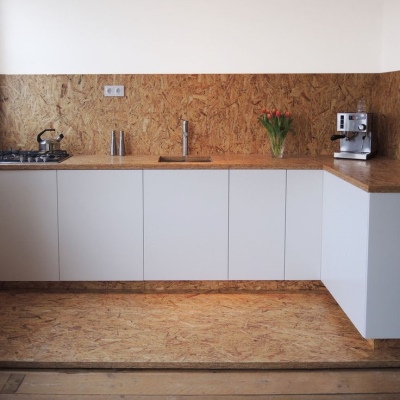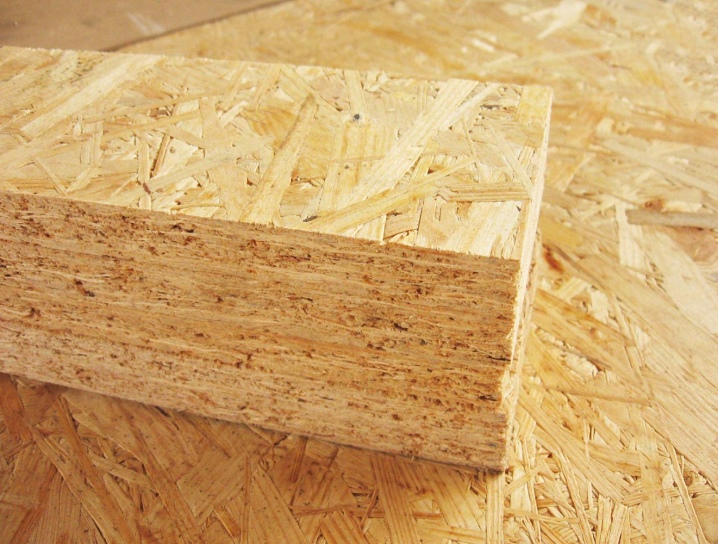Which is better: OSB or chipboard?

Many consumers do not understand well enough what is better - OSB or chipboard, how they differ and what to lay on the floor. Meanwhile, the difference between OSB and particleboard boards is quite significant. It is necessary to carefully understand what is stronger and stronger, more harmful and cheaper.

What is stronger?
The strength of wood composites is determined by several interrelated indicators:
- bending strength limit;
- elastic modulus;
- how firmly the fastener holds.

The OSB contains large chips. They are clearly oriented and form a relatively ordered structure. Therefore, theoretically, it can be expected that this material will be stronger than an ordinary particle board. But the obviousness in technology does not always work, and therefore one should first of all pay attention to the instructions of state standards. The GOST stipulates that for chipboard the following standards should be provided:
- bending resistance - not worse than 11 MPa;
- elastic modulus - at least 1600 MPa;
- ability to hold fasteners - from 35 to 55 N / m.
For OSB, even the minimum bending strength in the longitudinal direction is significantly higher - from 18 MPa. It can reach 20 MPa. The bending strength across the diameter, however, is somewhat less (no more than 10 MPa, and even 9 MPa corresponds to the standard indicators).

But according to all other criteria, OSB significantly wins. So, the elastic modulus in the longitudinal plane is not lower than 3500 MPa, and even its lower than that of the chipboard, the value in the transverse plane is fully justified; in addition, even the most mediocre manufacturers provide a fastening force of at least 80-90 N / m.
Resistance of materials to moisture
A similar technology of release does not allow, alas, to count on identical indicators of moisture resistance. They are noticeably higher in OSB. But you need to understand that there are several categories of such material at once. Not all of them are particularly resistant to water ingress.
However, with chipboard, everything is much worse - any of its varieties and types are extremely poorly tolerated by moisture. Even chipboard is protected only by a thin surface film.


What else is the difference between OSB and chipboard?
Particleboard is cheaper than the oriented option. but taking into account the weaknesses of this material (and above all the poor mechanical characteristics), its choice is justified only in the most extreme case. The overall reliability of the chipboard is very low. Yes, both materials - with sufficient adherence to technology - will not delaminate. But still, relatively fragile chipboard sheets are prone to shedding at the ends.

An important difference between the two concerns processability. Both chipboard and oriented structures can be without any problems:
- cut;
- drill;
- grind.
But chipboard material tends to crumble, and therefore its processing is less convenient. After its end, more garbage has to be removed. And it is impossible to tighten a screw or screw twice in the same hole without adding epoxy resin.

Comparison of chipboard and OSB is possible in other parameters. The connection of shavings according to the first technology forces the use of a larger amount of resins. Therefore, the intensity of toxic fumes will be higher.
In this sense, we can firmly say that chipboard is more harmful in this pair, and OSB, on the contrary, is safer. And you should not neglect such a risk. After all, we are not talking about some kind of wood resins, but about formaldehyde, which is recognized as one of the most toxic substances used in woodworking.Environmental qualities are especially important when it comes to the use of structures in children's rooms, kitchens, bathrooms and bedrooms.

A major difference also concerns the appearance. Oriented strand material has long been recognized by all experts as a more aesthetic solution. By its texture, it is much closer to natural wood. Often this coating is used to decorate interior walls and partitions "under varnish". But chipboard can be used for decoration only when using an outer layer (special film).
The density and mass of both designs are approximately the same. Likewise, resistance to insects and microscopic fungi is identical. If we also compare it with plywood, then the oriented slab turns out to be much cheaper.
A variety of materials are used in the production of chipboard, including sawdust. Oriented strand boards are produced strictly on the basis of high quality shavings. The shavings themselves are not stacked "just at random", but in a clearly worked out order.

What is the best choice?
Taking into account all that has been said, it becomes clear that it is the OSB that is most correct to lay on the floor. Particleboard is nothing more than a compromise option on a tight budget or in secondary buildings. Both materials can be laid out both on the crate and on the concrete screed, therefore, in this regard, they are equally versatile.

But it is also worth noting that it is possible to put chipboard on the logs only with a minimum distance between the bars; in the case of a concrete base, there is no such problem - the fastening is carried out using dowels, and the holes are made in advance with a perforator.
But even taking into account the almost always unambiguous choice in favor of OSB, it is necessary to understand that this material can have significant differences. For floor decoration, it is recommended to use a grooved type. Completely flat products have to be laid with a gap, and then saturated with sealant. OSB-1, OSB-2 are designed to work in rooms with low humidity, where there are no significant mechanical loads. More versatile in terms of resistance to moisture and mechanical strength, but also more expensive, OSB-3 and OSB-4 slabs.

Oriented structures are most often taken to pre-align horizontal surfaces. But under favorable conditions, they are also used for front finishing. Simple leveling of subfloors in dry rooms usually involves the use of OSB-2. And the slab of the first category is acceptable only for the ceiling and walls in a warm (heated) room.

Chipboard and OSB can be used equally under the tiles in the bathroom or in the pool - provided they are waterproofed. However, given the inherently increased hydrophobicity of the second material, the choice is clear. If left untreated, the coating can become infected with nests of mold and other microscopic fungi. The same requirement applies for finishing:
- kitchens;
- open balconies;
- shower cabins;
- hallways;
- attics;
- floors and walls in cellars, basements, basements;
- sheds;
- baths.

OSB is great for laying out under:
- carpet;
- linoleum;
- laminate;
- parquet;
- various types of parquet boards.

Important: for residential premises, a coating of category E1 is best suited. It is this group that is the safest among all chip materials. OSB panels are suitable not only for floors, but also for walls. In this sense, they are much better than any drywall. Such material is used for:
- attaching decorative lining;
- upholstery with various other panels;
- staining with all kinds of dyes (without treatment with putty, with the exception of joints in single places).














The comment was sent successfully.